|
 Secure Site
Secure Site
|
 |
Archive for the 'Well-being' Category
 Utamaro Kitagawa, The Courtesan Hanaogi of Ogiya, Ukiyo-e Woodblock Print As far back as 300 B.C., the philosopher Chuang Tzu observed that when an archer was practicing, he shot with calming relaxation and skill. When a moderate financial award was placed in front of the archer, he got a little tense, his aim faltered and he often missed the target. When a large award was offered for his accuracy, he became nervous and worried, with obvious results. This led Chuang Tzu to wryly observe that, “He who looks too hard on the outside gets clumsy on the inside.”
In modern times people who play golf find their swing is near perfect when there is no ball to hit. But once a ball is placed on the tee and someone is keeping score, the inexperienced golfer’s swing inevitably fails and the ball goes off its intended path. When a golfer has a drink, he often becomes more relaxed and his game improves. So even though a specific feat can be improved by artificial means, it is at the expense of our being fully present and reduces our ability to respond to other circumstances. Imagine how our performance in everyday life would improve if we could learn to find rest and calming relaxation from within ourselves.
The question is, “How could we relax in the process of living?” or, “How can we have rest in our daily lives? How do we live for the rest of our lives?”
 Ohara Koson (Shoson) 1877-1945, Ukiyo-e Here are six resting points or techniques that can assist us in finding rest and calming relaxation, peace, tranquility, and restoration within ourselves and within the great self that embraces and holds us all. Try one and you’re on your way to the rest of your life.
1. The Breath: Following the rise and fall of your breath can bring you to a peaceful and calm place and restore your energy. It brings you present. Allow your breath all the way into your belly to reduce stress. The key to natural and full breathing is in the exhalation – the letting go. However, don’t force anything.
2. The Nap: It is very underutilized in our culture. Twenty minutes is ideal but even a five-minute nap can be very restorative. Don’t go more than 20 minutes or you may feel groggy. If you only have a minute, try this. Hold some keys in your hands and bend forward in your chair with your lower arms resting on your thighs. As you nod off, the keys will drop and wake you up. Even in that minute, you will feel a little more refreshed. The point here is that taking a little time for yourself for rest, prayer, meditation, or spiritual exercises can profoundly affect the quality of your day. Remember to set your Zen Chime Timer to awaken you gently.
3. The Pause: Learning to pause is a great tool to have up your sleeve. Its value is in bringing you consciously present. You can pause a moment in your daily routine and say, “I am present. I am here, now.” Then allow yourself to be with whatever is revealed. A further refinement is to bring your attention to the pause between exhaling and inhaling. Even doing this once will give you a moment of rest and restoration.
4. Silence: The word “listen” contains the same letters as the word “silent.” Choose to be present and alert and to listen past the inner conversations of the mind. Listen past the sounds of the world and just listen to the silence. Listen attentively to whatever comes forward out of the silence. If things start to distract and disrupt you, bring your focus back to the silence. When you practice bringing your presence into the silence, you will experience a knowing and a wisdom that will start flowing within you. It will usually bring you to a state of peace, calm and clarity.
5. Doing nothing: A great way to interrupt the pattern of habitual doing. It is akin to entering a state of observation, where you perceive things clearly just for what they are. An analogy is watching boats going out to sea. You observe them as they pass you. Then you observe the next one. If you gawk or think about how you would like to be in a boat, you have moved out of observation. Observation is only about what is, not what you know or don’t know about a situation. The power that comes from that, internally, is tremendous. It’s an active place of neutrality. The process of observing what is, is the process that releases and restores us.
6. Meditation – Resting in Yourself: “To the mind that is still, the whole universe surrenders.” Lao-Tzu. When you haven’t developed an intimate relationship with life or with yourself, you’ll tend to look toward having sex or acquiring more money, or to any attractive distraction to fill the emptiness inside. To fill yourself, you have to be prepared to spend time alone – quality time with yourself, not with a good book, not watching television, art or with music. Although those have their place, learn to be quiet with your own inner self. Any time you can bring your focus onto one thing, a flower, a sacred word, a scene in nature, you are meditating. The simplest way to meditate is to observe the rising and falling of your breath.
 Zen Alarm Clock, Ukiyo-e Hokusai Wave Dial Face, mediation timer and clock Adapted from Men’s Health, June 2003 by Paul Kaye, DSS, President of the Movement of Spiritual Inner Awareness (MSIA)
Now & Zen’s – The Zen Alarm Clock Store
Meditation Time Shop
1638 Pearl Street
Boulder, CO 80302
Posted in Bamboo Chime Clocks, Chime Alarm Clocks, Japanese Inspired Zen Clocks, Meditation Timers, Meditation Tools, Natural Awakening, Now & Zen Alarm Clocks, prayer, Progressive Awakening, Well-being
 Peonies at Hyakken, #18 from the series 'Tōkyō Meisho Sanjurokkasen, Utagawa Shigenobu (1826 - 1869)
The bee emerging
from deep within the peony
departs reluctantly.
-Basho-
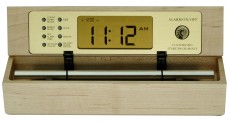 maple meditation timer and chime alarm clock called The Zen Alarm Clock, digital style in maple
Now & Zen’s Chime
Alarm Clock &
Meditation Timer Store
1638 Pearl St.
Boulder, CO 80302
Posted in Bamboo Chime Clocks, Japanese Inspired Zen Clocks, Japanese Poetry, Meditation Timers, Meditation Tools, mindfulness practice, Natural Awakening, Now & Zen Alarm Clocks, Progressive Awakening, Ukiyo-e, Well-being, Zen Timers
 cherry blossoms, Now & Zen Inc. makers of Zen Timers Meditation has been defined as:
“self regulation of attention, in the service of self-inquiry, in the here and now.”
-Maison, Werheimer, & Kabat-Zinn (1999)
The various techniques of meditation can be classified according to their focus. Some focus on the field or background perception and experience, often referred to as “mindfulness”; others focus on a preselected specific object, and are called “concentrative” meditation.
In mindfulness meditation, the meditator sits comfortably and silently, centering attention by focusing awareness on an object or process (such as the breath; a sound, such as a mantra, koan or riddle-like question; a visualization; or an exercise).
wikipedia.org
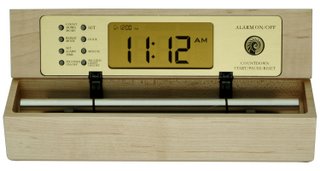 maple zen timer for meditation and yoga Now & Zen’s Meditation Timer Shop
1638 Pearl Street
Boulder, CO 80302
(800) 779-6383
Posted in Cherry Blossoms, Japanese Inspired Zen Clocks, Meditation Timers, Meditation Tools, Natural Awakening, Now & Zen Alarm Clocks, Progressive Awakening, Well-being, Yoga Timer, Yoga Timers by Now & Zen, Zen Timers
 Dream, Pablo Picasso Birds do it. Cats do it. And Spaniards most especially do it—every day, in broad daylight.
They nap. Proudly, without a hint of embarrassment. Grown adults—executives, teachers, civil servants—wink off in the middle of the workday like kindergartners at mat time. From 1 or 2 o’clock to 4:30 or so every afternoon, Spain stops the world for a stroll home, a leisurely meal, a few z’s. Common Market technocrats have informed the Spanish that this is not the way things will get done in the oft-threatened unified Europe. The Spanish reply with a flourish of rioja and snooze alarms. ¡Viva siesta!
At a time when productivity is the world’s largest religion, the siesta tradition lives on. In Spain, work operates under the command of life, instead of the other way around. No task is so critical that it can’t wait a couple of hours while you attend to more important matters like eating, relaxing, or catching up on sleep from a night on the town. When the midday break hits, offices empty and streets clear as if by the hand of Rod Serling. Befuddled foreigners left behind quickly learn that they have entered a new circadian order.
Taking a long break in the middle of the day is not only healthier than the conventional lunch; it’s apparently more natural. Sleep researchers have found that the Spanish biorhythm may be tuned more closely to our biological clocks. Studies suggest that humans are “biphasic” creatures, requiring days broken up by two periods of sleep instead of one up-till-you-drop “monophasic” shift. The drowsiness you feel after lunch comes not from the food but from the time of day. “All animals, including humans, have a biological rhythm,” explains Claudio Stampi, director of the Chrono Biology Research Institute in Newton, Massachusetts. “One is a 24-hour rhythm—we get tired by the end of the day and go to sleep—and there is a secondary peak of sleepiness and a decrease in alertness in the early afternoon. Some people have difficulty remaining awake, doing any sort of task between one and four in the afternoon. For others it’s less difficult, but it’s there. So there is a biological reason for siestas.”
 Digital Zen Alarm Clocks, available in maple, walnut, bamboo, and black lacquer Unlike the average lunch break, the siesta is a true break in the action because there is no choice but to come to a full and complete stop. You can’t do errands; the shops are closed. You can’t make business calls; nobody’s at the office. Most people go home for lunch, or get together with family or friends for a glass of vino, and nod out afterwards.
Like a lot of us in the land of time scarcity, I find it harder and harder to shut it off, to switch off work mode and be social—that is, be unproductive, and just be. The divide is blurred by a volatile economy of all-consuming competition that has turned off-hours into off-site catch-up. Blink and it’s Monday again. The culprit, says David Scott, an associate professor of recreation, park, and tourism sciences at Texas A&M, is the accelerating cult of efficiency.
“We are an efficiency-oriented society,” he says. “It is perhaps the dominant value in this culture. The faster things get done, the better off we’re going to be. The idea of efficiency at all costs seems to be all-pervasive. It tends to invade our leisure. Unfortunately, socializing doesn’t have a ‘yield.’ It’s hard to develop relationships; those things take time.”
The siesta lifestyle is rooted in a culture with values that are anathema to the ascendant economic order, so don’t expect the rest of Europe to adopt Spanish hours. A few Spanish firms have begun shortening their siesta time as the eurodollar era approaches. But maybe, being the great taskmasters we are, we could find a way to put one quality-of-life item on the agenda each day. We could even give it a productive rationale: Life expectancy in Spain is two years longer than in the United States. Think of all that extra output.
Our Digital Zen Clock’s long-resonating Tibetan bell-like chime makes waking up a beautiful experience – its progressive chimes begin your day with grace. When the clock’s alarm is triggered, the acoustic chime bar is struck just once … 3-1/2 minutes later it strikes again … chime strikes become more frequent over 10 minutes … eventually striking every 5 seconds until shut off. As they become more frequent, the gentle chimes will always wake you up – your body really doesn’t need to be awakened harshly, with a Zen Clock you’re awakened more gradually and thus more naturally.
What makes this gentle awakening experience so exquisite is the sound of the natural acoustic chime, which has been tuned to produce the same tones as the tuning forks used by musical therapists. According to the product’s inventor, Steve McIntosh, “once you experience this way of being gradually awakened with beautiful acoustic tones, no other alarm clock will ever do.”
adapted from Escape Mazaine, July 1998
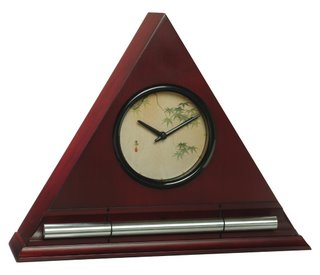 Japanese Leaves Dial Face in Burgundy Finish by Now & Zen Now & Zen – The Peaceful Chime Alarm Clock Store
1638 Pearl Street
Boulder, CO 80302
(800) 779-6383
Posted in Chime Alarm Clocks, Japanese Inspired Zen Clocks, mindfulness practice, Natural Awakening, Now & Zen Alarm Clocks, Progressive Awakening, Sleep Habits, Well-being
 rest and relaxation You know a little too well what your kitchen looks like at 3 a.m. You’ve memorized the light patterns on your bedroom ceiling, counted thousands of sheep, and watched your Zen Alarm Clock for countless hours. And you’ve come to expect the thump of the newspaper at the front door a few minutes after 5.
If this sounds familiar, you’re in good company: Sixty-seven percent of American women surveyed in last year’s National Sleep Foundation poll said they regularly have trouble sleeping. Many of the culprits are hallmarks of our current culture: long work hours, stress, sugar-laden cappuccinos, wanting to fit too much into one day. Several recent reports, including a study published in Social Science & Medicine titled “Is Sleep Really for Sissies?,” have suggested that we value what we do during the day much more than what goes on at night.
But good sleep isn’t something we can afford to take off our to-do list. Like a nutritious diet and exercise, sleep is a foundation for health — not to mention sanity.
“It’s a bedrock,” says Paul Glovinsky, Ph.D., coauthor of “The Insomnia Answer.” As anyone with sleep trouble knows, a single bad night can hamper productivity, memory, even basic conversation skills. But it’s over time that insomnia really takes its toll. “We’ve seen that, in all kinds of ways, deficits accrue when you don’t sleep.”
 Bamboo Digital Chime Clock, for a progressive awakening Poor sleep may set you up for heart problems, for instance, plus lowered immunity, depression, diabetes, obesity, and chronic pain. One study actually proved that sleep deprivation can damage our mood in a very real way: Compared with those of rested people, the emotional centers of the brain in sleep-deprived people were 60 percent more reactive to negative experiences.
So what’s a droopy-eyed, overcaffeinated, dream-deficient woman to do? Committing to good sleep hygiene is a start. But it also pays to identify your unique sleep profile. There’s no single insomnia pattern; there are many. And delving into the details of yours can help you overcome it.
We went to several sleep experts with some common sleep types, like the person who can’t stop thinking, the one who wakes up at odd times, and the one who keeps finding excuses to push off bedtime (Really? Another episode of “House Hunters?”).
As it turns out, these patterns often have distinct causes and solutions. Don’t be surprised if more than one profile rings true; your patterns may fluctuate. The key is to give some serious thought to your sleep life. Use The Zen Timepiece with the Bowl /Gong to waken you. Try turing it around so that the digital display doesn’t show. The quality of your waking life — not to mention your health — depends on it.
Boulder, Colorado—an innovative company has taken one of life’s most unpleasant experiences (being startled awake by your alarm clock early Monday morning), and transformed it into something to actually look forward to. “The Zen Alarm Clock,” uses soothing acoustic chimes that awaken users gently and gradually, making waking up a real pleasure.
The luxurious awakening provided by the Zen Alarm Clock is part of the growing preference for things natural—natural foods, natural fibers, and now, natural acoustic sounds. Like organic tomatoes in your salad, the organic sounds of the Zen Alarm Clock’s sweet acoustic chimes are truly a gourmet experience.
What makes this gentle awakening experience so exquisite is the sound of the natural acoustic chime, which has been tuned to produce the same tones as the tuning forks used by musical therapists. According to the product’s inventor, Steve McIntosh, “once you experience this way of being gradually awakened with beautiful acoustic tones, no other alarm clock will ever do.”
Adapted from Body + Soul Magazine, May 2008 by Sarah Schmelling
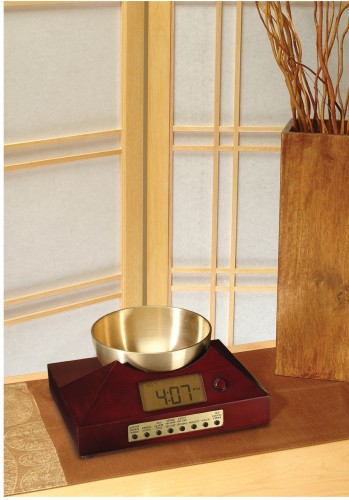 Zen Alarm Clock for a Gentle Awakening with a Bowl Gong and Mindfulness Timer Now & Zen’s Alarm Clock Shop
1638 Pearl Street
Boulder, CO 80302
(800) 779-6383
Posted in Bamboo Chime Clocks, Chime Alarm Clocks, Japanese Inspired Zen Clocks, Natural Awakening, Now & Zen Alarm Clocks, Progressive Awakening, Sleep Habits, Ukiyo-e, wabi-sabi, Well-being, Zen Timepiece by Now & Zen, Zen Timers
 Toyohara, Kunichika, 1835-1900 Saruwaka-cho Kogiku Too frazzled to focus at work? Meditation may help hone your attention — even if you’re new to the practice. In a University of Pennsylvania study, a group of 17 beginners showed great improvements in focus after meditating for a half-hour, five times a week for eight weeks. Regular meditation also enhanced their ability to manage tasks and stay alert while working.
To ease into a practice, find a quiet place every day, set your Zen Meditation Timer and simply focus on following your breath. “Even if you’re doing five minutes, three times a day, it can help a lot in getting your body accustomed to slowing down,” says Vandita Kate Marchesiello, director of the Kripalu Yoga Teachers Association. For more guidance, she recommends picking up a meditation book, CD, or DVD, or attending a local class.
Our Mindfulness Clock & Timer, called The Zen Clock serves as a countdown and interval timer for yoga, meditation, bodywork, etc.; and it can also be set to chime on the hour as a tool for “mindfulness.”
adapted from Body + Soul, October 2007
 Black Lacquer Zen Alarm Clock and Meditation Timer
Now & Zen’s Mindfulness Clocks and Timer Store
1638 Pearl Street
Boulder, CO 80302
(800) 779-6383
Posted in Bamboo Chime Clocks, Chime Alarm Clocks, intention, Meditation Timers, Meditation Tools, mindfulness practice, Now & Zen Alarm Clocks, Ukiyo-e, Well-being
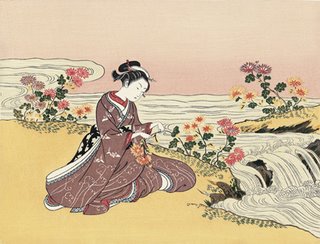 Harunobu Suzuki, A Girl Collecting Chrysanthemum Dew by the Stream Meditation is often credited with helping people feel more focused and energetic, but are the benefits measurable?
A new study suggests that they are. When researchers tested the alertness of volunteers, they found that the practice proved more effective than naps, exercise or caffeine. The results were presented at a recent conference of the Society for Neuroscience.
The researchers, led by Prashant Kaul of the University of Kentucky, took 12 students who did not meditate and taught them the basics in two short sessions.
Then, over a series of weeks, the students were asked to come in and take a test devised to measure skills like reaction time. The tests involved a series of visual cues on a display screen that the volunteers had to react to by pushing the correct button.
The students were asked to take the tests in mid- to late afternoon, when people tend to be sleepiest. They did so before and after 40 minutes of meditating, napping or exercising, or after taking caffeine. Napping produced poor results, presumably because of “sleep inertia,” the researchers said.
Caffeine helped, and exercise was unpredictable.
Earlier studies have found that people are awake while meditating but that their brains undergo changes similar to patterns found in sleep. Some studies have found that people who meditate a lot report sleeping less, so the researchers were curious to see if meditation could serve the same function as sleep. The results support the idea that it can.
In fact, when some of the students were asked to skip a night’s sleep and then take the test, the researchers said, meditation was even more helpful.
Although meditation can be done in almost any context, practitioners usually employ a quiet, tranquil space, a meditation cushion or bench, and some kind of timing device to time the meditation session. Ideally, the more these accoutrements can be integrated the better. Thus, it is conducive to a satisfying meditation practice to have a timer or clock that is tranquil and beautiful. Using a kitchen timer or beeper watch is less than ideal. And it was with these considerations in mind that we designed our digital Zen Alarm Clock and practice timer. This unique “Zen Clock” features a long-resonating acoustic chime that brings the meditation session to a gradual close, preserving the environment of stillness while also acting as an effective time signal.
adapted from The New York Times, October 2006 by Eric Nagourney
 Digital Zen Alarm Clocks, meditation timers and alarm clocks with chimes Now & Zen’s Meditation Timer Store
1638 Pearl Street
Boulder, CO 80302
Posted in Chime Alarm Clocks, Japanese Inspired Zen Clocks, Meditation Timers, Meditation Tools, Natural Awakening, Now & Zen Alarm Clocks, Progressive Awakening, Sleep Habits, Well-being
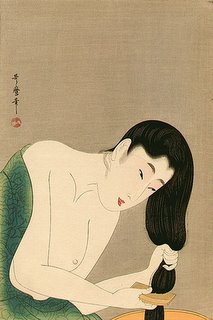 Utamaro Kitagawa, Bijin Combing Her Hair, 1750-1806 The key to create a wind-down period before bedtime is to create some space between your busy day and sleep time. “You can’t just work until 9 at night, and then stick your head on the pillow and fall asleep,” Khalsa says. So turn off the television, computer, and radio. Cut down on or eliminate evening classes and exercise that leaves you feeling amped up.
When you come home, honor this transition by playing relaxing music, lighting candles, or putting on your favorite pajamas and set your Zen Alarm Clock. Think of the yoga precept of pratyahara: Withdraw your senses in order to turn inward.
Our unique “Zen Clock” features a long-resonating acoustic chime that brings the meditation session to a gradual close, preserving the environment of stillness while also acting as an effective time signal.
adapted from yogajournal.com ‘Sweet Slumber’ by Nora Isaacs
 Zen Alarm Clock for a Gentle Awakening with a Bowl Gong
Now & Zen’s Chime Timer
1638 Pearl Street
Boulder, CO 80302
Posted in Bamboo Chime Clocks, Japanese Inspired Zen Clocks, Meditation Timers, Meditation Tools, mindfulness practice, Natural Awakening, Now & Zen Alarm Clocks, Progressive Awakening, Sleep Habits, Ukiyo-e, Well-being, Zen Timepiece by Now & Zen, Zen Timers
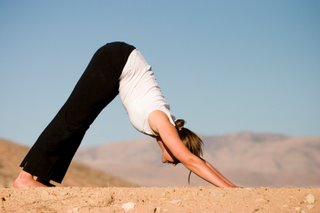 yoga downward dog pose This multipurpose pose stretches and releases tension in key parts of your body (shoulders, legs) while at the same time strengthening and toning them. Make it part of your regular practice and feel your energy soar.
Here’s How To Do It
Start on all fours on a yoga mat, with your hands aligned with your shoulders and your knees directly under your hips. The tops of your feet should be on the mat.
Inhale, curl your toes under, and spread your fingers. Exhale, raise your tailbone, and push into the mat with your hands. Elongate your spine, and straighten your legs. Keeping your head neutral and your back flat, activate the muscles in your arms and legs. Push your heels down toward the floor. Hold for four to five breaths. Bend your knees and relax. Set your Zen Yoga Timer to 30 seconds.
Refine Your Technique
As you incorporate the pose into your practice, use the following strategies.
1. Spread your fingers as wide as possible, pressing the base of your index fingers into the floor.
2. Keep your head between your arms or let it hang, whatever feels more comfortable.
3. Lengthen your spine, lifting your sitting bones up; imagine someone pulling your hips and back.
4. Keep your knees straight, but not locked. Hold the outer thigh muscles firm, and roll the upper thighs slightly inward.
5. Your heels may or may not reach the floor; keep stretching them, but don’t strain.
6. Hold your shoulder blades firm, drawing them in and down, toward your tailbone.
adapted from Body + Soul Magazine, November 2009 by Tania Hannan
Use our unique “Zen Clock” which functions as a Yoga Timer. It features a long-resonating acoustic chime that brings your meditation or yoga session to a gradual close, preserving the environment of stillness while also acting as an effective time signal. Our Yoga Timer & Clock can be programmed to chime at the end of the meditation or yoga session or periodically throughout the session as a kind of sonic yantra. The beauty and functionality of the Zen Clock/Timer makes it a meditation tool that can actually help you “make time” for meditation in your life. Bring yourself back to balance.
 Digital Zen Alarm Clocks, yoga timers with a chime
Now & Zen – The Yoga Chime Timer Store
1638 Pearl Street
Boulder, CO 80302
(800) 779-6383
Posted in Bamboo Chime Clocks, Chime Alarm Clocks, Meditation Timers, Meditation Tools, mindfulness practice, Now & Zen Alarm Clocks, Well-being, Yoga Timer, Yoga Timers by Now & Zen
 still the mind Despite the oft-heard instruction to “still the mind,” a meditation practice is not meant to help you get rid of all your thoughts—and you wouldn’t want it to. Your ability to think is, after all, one of the greatest gifts in life, something to truly cherish.
When you start a meditation practice, you are simply training yourself to become more aware of your thoughts and, more important, of how you relate to them—a process that can change the very landscape of your life.
Using a kitchen timer or beeper watch is less than ideal. And it was with these considerations in mind that we designed our digital Zen Alarm Clock and practice timer. This unique “Zen Clock” features a long-resonating acoustic chime that brings the meditation session to a gradual close, preserving the environment of stillness while also acting as an effective time signal.
adapted from Yoga Journal, ‘Presence of Mind’ by Janice Gates
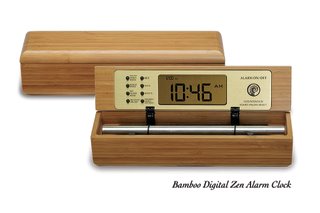 Bamboo Zen Timers, a meditation timer Now & Zen’s Chime Meditation Timer Shop
1638 Pearl Street
Boulder, CO 80302
Posted in Japanese Inspired Zen Clocks, Meditation Timers, Meditation Tools, Now & Zen Alarm Clocks, Progressive Awakening, Well-being, Yoga Timer, Zen Timers
« Previous Page — « Previous Entries
Next Entries » — Next Page »
|
|
|
|